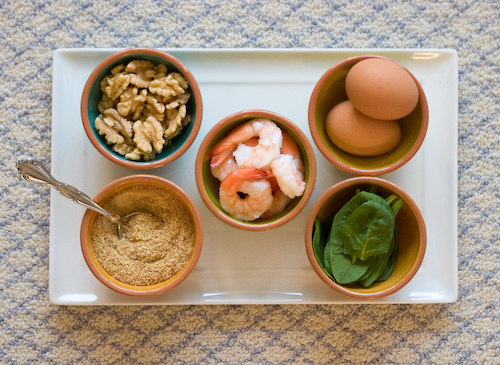Healthy Fats?

The quick answer: Plain and simple, most of what you’ve heard about fat in your diet is wrong. Enjoy the traditional fats in moderation.
_______________________________________________________________________
Politics and Food
We’ve nothing to say about the current presidential race—we’re keeping our focus on the food reformation. Well, one thing. Because this blog is about “wisdom,” won’t you all take a thoughtful view of what’s best for our country and vote wisely?
But we do have something to say about the role of politicians in our current food mess. Maybe it’s because women are more about nurturing and politicians are nearly all men, but on nutrition the pols do have a way of getting things backwards. Take the subject of fats for example, as recounted in Michael Pollan’s book, In Defense of Food.
If the consequences of this tale weren’t so dire, it would make a hilarious story. Back in 1968 the esteemed Senator George McGovern convened a select committee that addressed the role of diet in chronic disease. After ten years the committee got to a reasonable conclusion: We should eat less animal products (and, thusly, more plants). There are other factors that affect chronic disease—such as lack of exercise, smoking, and our high sugar diet—but this was a pretty good start.
Well, the dairymen and cattlemen saw this is as bad for business and brought all their guns to bear on Senator McGovern and his committee. You’ll recall that McGovern was from a state with a lot of ranches. A compromise resulted: Rather than recommend less red meat and dairy, the committee meekly suggested that Americans “choose meats, poultry, and fish that will reduce saturated fat intake.”
It was bad enough to replace “eat less” with the verb “choose,” which kind of sounded like a recommendation. But there was a worse mistake: The committee decided that the villain was saturated fats, which had been safely eaten for centuries. Even worse, traditional fats like butter were condemned and new factory-made fats—mainly trans fat-laden hydrogenated vegetable oils found in Crisco, margarine, and salad oils—were recommended.
Though the outcome was a bonanza for Food Inc, it was a disaster for the average American. And for McGovern also—in the next election the meat and dairy industry threw their support behind his opponent and drove him from office. It was a display of power and vengeance not missed by other politicians.
Healthy Fat Basics
Four of our 52 Healthy Changes are dedicated to eating healthy fats and avoiding unhealthy fats. HEre is a summary of the frist three:
- Our 2nd Healthy Change addressed the danger of trans fats, particularly from deep fried foods: “Never buy deep fat fried foods.” We also noted the role of a remarkable woman, Dr. Mary Enig, in exposing the danger of trans fats.
- In Healthy Change #15 we talked about the vital role of omega-3 fats in our diet and recommended consciously adding them to every meal, either in the short-chain form (dark greens, etc.) or the long-chain form (fish, eggs, etc.). Your brain is 60% fat and 25% is long chain omega-3 fats. Healthy fats protect against many ills, including dementia.
- Omega-6 fats are necessary but we eat them to excess. Because they compete with omega-3 fats, it’s important to have a balance in order to benefit from omega-3 intake. Two ways to reduce omega-6 fats are to avoid deep fat fried foods, and to avoid starchy foods fried in man-made fats, like chips. Americans eat a lot of chips so Healthy Change #28 said, “Limit chips to national holidays, or for scooping healthy dips and salsas.”
Cutting Calories
Our fourth and final Healthy Change on fats encourages the consumption of traditional fats (olive oil, butter, etc) in moderation. As you know a gram of fat, regardless of the type, contains 9 calories. By contrast, a gram of carbohydrate or protein has just 4 calories. Because the modern American diet (MAD) has an excess of calories and fat is calorie dense, we’re often told to avoid fats. We think it better to restrict the worst source of calories—excessive sugar intake—and enjoy healthy fats in moderation.
In Healthy Change #9, we asked families to work together to reduce their intake of meat: “Agree on a ‘sparing’ meat intake goal as a family and write it down. Let your goal guide your menus.” Although we defend the consumption of saturated fat, we agree that Americans eat too much, particularly with their meat. We need to be moderate. There’s a natural and beneficial outcome: If you’re sparing with the meat in your menu, you’ll also reduce your intake of saturated fats to a healthier level and cut calories.
Healthy Change #41:
“Eat traditional fats (olive oil, butter, coconut oil, etc.) in moderation.” It's naturally simple—eat the fats your ancestors ate.
Toxic Buttery Flavor
Because we support the use of traditional fats like butter, it’s important that we distinguish between real butter and foods described as “buttery.” Buttery is a taste claim attached to many factory foods, like the new spreads that have replaced margarine, microwave popcorn products, some candies, and many baked goods. You won’t see the chemical behind that buttery taste on the ingredient list; it’s usually hidden under the chemical stew of “artificial flavors.”
The chemical commonly used to give the buttery taste contains diacetyl. Diacetyl is toxic to humans and has been linked in the laboratory to Alzheimer’s disease. If you watched this week’s Dr. Oz (see it here), he spoke about the possible danger of diacetyl and recommended it be avoided until more is known. Sounds like a good application of the “century rule” to me. (Century Rule: Avoid foods that haven’t been around for at least a century. This rule basically rules out most factory foods, especially those containing “artificial flavors.”)
Please comment: Is there a fat or oil you see as particularly bad? What are your favorite healthy fats? What oils do you most use in cooking.

 Tuesday, October 9, 2012 at 8:13AM
Tuesday, October 9, 2012 at 8:13AM




